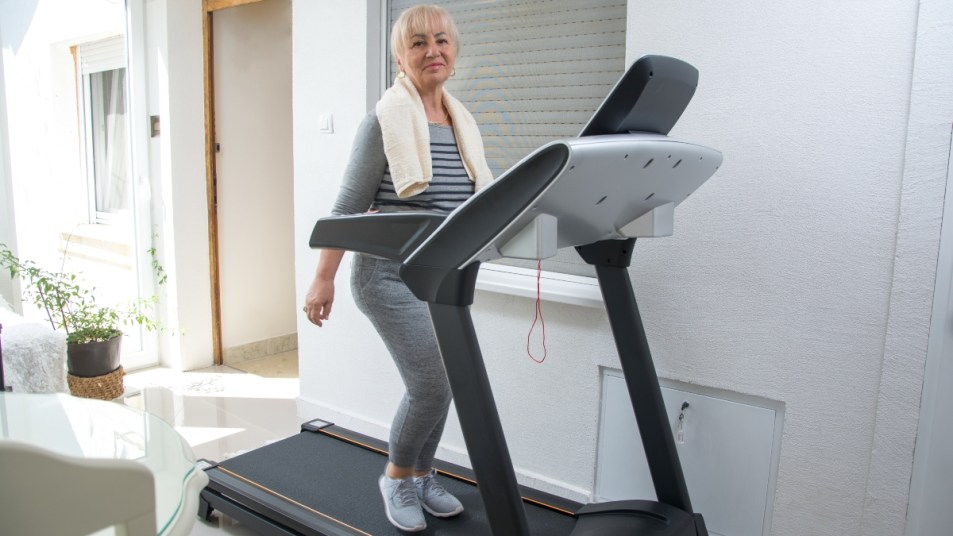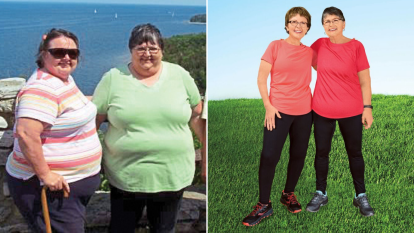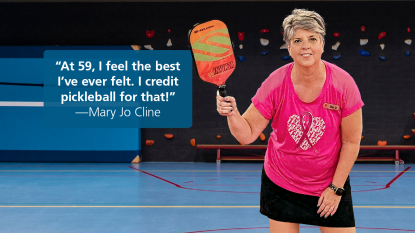Make Walking More Exciting: 6 Treadmill Moves That Boost Balance, Knee Strength, and Bone Density
Add some pep to your step.

Here’s something we already know: Walking on a treadmill has excellent benefits for your health. Research shows that walking in general helps you retain muscle as you age, burn fat, and lower your heart disease risk. And a treadmill is the perfect way to get you walking inside. Its smooth belt offers predictability (unlike an uneven sidewalk) which reduces your risk of tripping. Plus, the treadmill is great for multitasking — set it up in front of your TV, and you won’t even realize that you’ve walked for an hour.
Take it from me: I recently started using a Walking Pad A1 Pro, and it’s one of the best exercise products I’ve ever had. It keeps me moving during a busy day of work, and I often don’t realize I’ve completed 10,000 steps until I look down at the digital screen. It’s relatively quiet, easy to fold and roll away when not in use, and it has performed very well in the few months that I’ve had it.
However, I wanted to take things one step further. To get even more use out of my Walking Pad on the daily, I wondered if I could add a few simple movements to my walking routine. I started adding six moves to my day when I needed a pick-me-up, and I’m so happy that I did.
These moves work your balance and coordination — two factors that are key to leading an active, independent life as you age. Plus, the following exercises are designed to increase bone density and strengthen the muscles that protect your knees. Ready to get started? Check out these simple and effective treadmill exercises demonstrated by Dr. Rami Hashish, PhD, DPT.
Related: Doctor’s Best Natural Ways to Strengthen Bones So You Avoid Osteoporosis Drugs
1) High Stepping
“High stepping will help you improve your balance, as well as further develop your hip flexor strength,” Dr. Hashish says. Though often overlooked, the hip flexors are an important set of core muscles that stabilize the pelvis and spine. Keeping these strong helps you move throughout your day with a lower risk of injuring your lower back.
To do: Set the treadmill speed between 0.75 and 1 miles per hour. Lift your knee with every step. Repeat for a full minute (the longer you go, the more you’ll feel it in your abdominal muscles too — a bonus!)
2) Side Stepping
“Side stepping helps strengthen the sides of the hips and legs, which in turn helps to improve lateral ankle stability,” Dr. Hashish explains. Since we often practice exercises in only a forward motion, lateral (side-to-side) movements get neglected. But working on your side-to-side coordination is an excellent way to keep you injury-free during everyday activities, like sweeping and gardening.
To do: Set the treadmill speed between 0.75 and 1.25 miles per hour. (Start at the lower speed if you are new to this.) Hold onto your standing desk or the handle of the treadmill with your right hand. Then, turn your body to the left and begin side-stepping. Don’t take your hand off the desk or handle until you feel comfortable. Perform the movement for a minute, take a minute rest walking forward, then repeat on your right side — holding onto the desk or treadmill handle with your left hand.
3) Skipping
“Skipping helps increase the heart rate and help burn calories,” says Dr. Hashish. “Over time, it helps improve balance, coordination, and bone density.” Indeed, a 2018 analysis of nine scientific studies found that up to three skipping sessions weekly improved strength in adults over 50 years old. (The skipping sessions were quick; three sets of 10 jumps, with a minute’s rest between each set.)
To do: Set the treadmill speed between 1.25 and 2 miles per hour. Hold the treadmill handles and skip 10 times. (Try your best to put little weight on the handles as you jump.) Walk for one minute. Repeat three sets — just like in the study. As you progress and feel comfortable, stop holding onto the handles.
If you aren’t ready to skip or you have a walking treadmill, try this modification: Hold onto the sides of your treadmill or your desk and lift up onto your toes with each step — but don’t jump. In other words, skip without letting your toes leave the ground.
4) Walking Backwards
“Backwards walking helps improve quadriceps function [and] hamstring flexibility, and helps to burn more calories,” Dr. Hashish says. In addition, it can improve your gait, balance, and overall mobility — which is why this move is often used in physical therapy.
To do: Set the treadmill speed between 0.75 and 1.25 miles per hour. (New to this move? It can feel scary and fast when you first try it, so start slowly, at 0.75 mph.) Use the handles for balance as you turn backwards, and let go of the handles once you are in position, walking backwards, and feeling comfortable. Continue walking backwards for one full minute, then grab hold of the handles again when you turn back around.
Note: If you have a standing treadmill, turn around while the speed is at 0.75. Then use your remote control to increase the speed if you feel comfortable. Lower the speed back down when you are ready to turn and face front once more.
5) Walking Up an Incline
“Walking up an incline helps to increase your heart rate, as well as activate your hamstrings, glutes, and calves,” Dr. Hashish explains. This might sound like a minor change to traditional walking, but it can have a big impact; inclined walking adds more resistance, so it better activates your hamstrings, glute, and calf muscles. And, just like walking with no incline, it’s easy on the joints.
To do: Set the treadmill speed to a comfortable pace. Add an incline, and increase it by one increment at a time, as you feel ready to do so. Maintain a steady pace on the incline for five minutes or more. Keep track of your heart rate, and make sure it doesn’t go too high — ask your doctor about your max heart rate during exercise. (Note: Most walking treadmills don’t have an incline, so you won’t be able to perform incline moves on a walking treadmill.)
6) Walking Backwards Up an Incline
Ready for a challenge? “Walking backwards up an incline not only targets your calf muscles, but also helps improve hamstring and calf mobility,” says Dr. Hashish. “All the while [it’s] increasing heart rate [and] helping you to burn calories.” Improving your legs’ range of motion also reduces your risk of injury.
To do: Set the treadmill speed between 0.75 and 1.25 miles per hour. Add an incline between level 0.5 and level 2. Walk at your chosen speed an incline for a minute. Then, carefully turn around using the handles for balance. Walk backwards for a full minute, then turn around to face the front. Repeat once or twice more if you feel comfortable.
FAQs
How often should I perform these exercises? Anytime you use your treadmill, try doing at least one or two of these exercises. Warm up first with five to 10 minutes of walking, and you’re good to go.
Is it safe to do these moves on a walking treadmill? Yes, though it depends on your balance and coordination; many walking treadmills don’t have handles. If this type of treadmill is all you have, gently hold onto your standing desk for extra balance during moves. Note that walking treadmills usually don’t have incline either, so you wouldn’t be able to do the incline movements.
What treadmill do you recommend? If you’re looking for a traditional treadmill with incline, we recommend the Proform Carbon T7 Smart Treadmill. If you’re looking for an walking treadmill, we recommend the Walking Pad A1 Pro, which is relatively quiet and comes with a remote, so you don’t have to bend down to alter your speed. It also folds and has wheels, so you can store it when not in use. See more of our product recommendations here.
For more brilliant ways to boost your walking program:
Women Over 50 Are Losing 100+ lbs Without Dieting Just By Walking Like *This*
For Some Women, Walking Slowly Burns More Belly Fat Than Walking at a Faster Pace
This content is not a substitute for professional medical advice or diagnosis. Always consult your physician before pursuing any treatment plan.













